Last Updated on February 27, 2025 by Owen McGab Enaohwo

Imagine sailing a ship without a map. No matter how hard you try, you’re bound to run into obstacles. This is what it feels like running a business without a solid quality management system.
Most businesses start well, but maintaining high standards becomes increasingly difficult as the operations grow, especially with the pressure to scale. In many cases, business owners and employees lose sight of the systems that initially drove success, leading to substantial company inefficiencies, costly errors, and customer dissatisfaction.
Customers are more likely to switch to a business that offers high-quality products and services. However, a consistent quality management framework makes all the difference—whether you exceed customer expectations or deliver subpar quality.
So, how can you streamline all your efforts to maintain quality in every section of your business?
In this article, we’ll explore the fundamentals of quality management, its benefits to your business, and how you can simplify the implementation process.
What You’ll Learn in This Guide
Benefits of Quality Management in an Organization
How to Implement Quality Management With SweetProcess
Proven Frameworks for Quality Management
Tools for Enhancing Quality Management in an Organization
Principles of Quality Management
Enhance Your Quality Management Process With SweetProcess
What Is Quality Management?
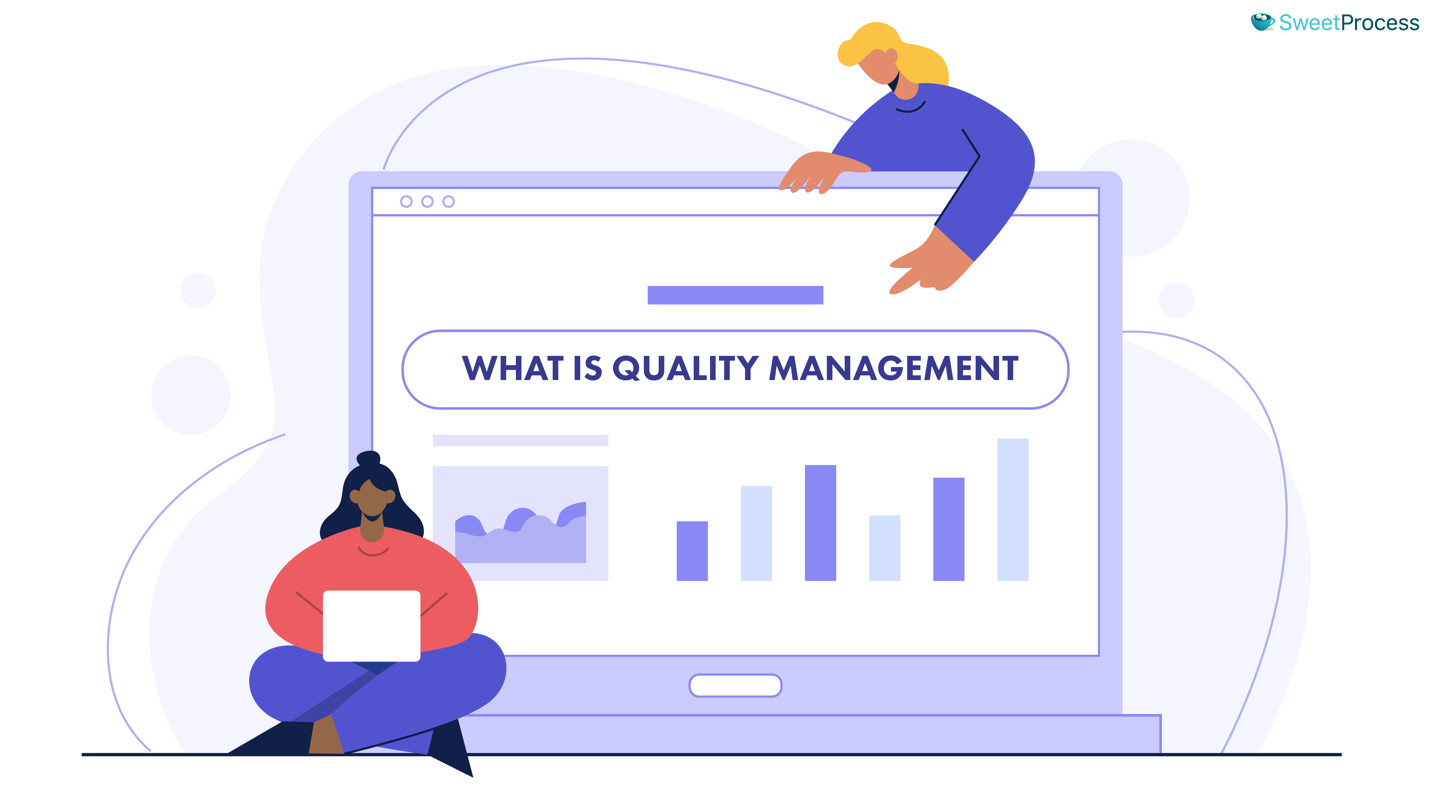
Quality management covers all the practices and processes an organization uses to ensure that the products and services meet or exceed customer expectations. Businesses incorporate tools and activities from product development to manufacturing and customer service to achieve and maintain a desired level of excellence.
With the right system, business owners can continually improve this standard. Quality management has four components.
- Quality planning: This involves identifying the quality objectives of your business and defining how you’ll meet them. With a plan in place, you can draft a quality policy to guide your team.
- Quality assurance: How will you know if your product and service meet the specified requirements? You need to monitor the systems using quality assurance processes. This way, you can identify areas that require more focus and improvement.
- Quality control: You also need to uphold the quality process continuously. Quality control allows you to verify whether products and services conform to the set standards.
- Quality improvement: As you collect insights from your quality processes, you can enhance them to improve your chances of better outcomes.
Now that you understand the basics of quality management, it’s time to implement it effectively. Try SweetProcess today and start building streamlined procedures for your business.
Benefits of Quality Management in an Organization

Implementing a solid quality management system (QMS) can transform your business. It’s your best bet if you want to deliver consistent results and improve your company processes. Let’s take a closer look at the benefits you get:
Achieves Consistency
We’ve all encountered a product or service that was high quality for a few years, and then things started going downhill. What did you do? You probably switched to a competitor.
Maintaining consistency helps your business overcome such challenges. With the proper QMS, your team will stick to the provided processes or procedures. And with this, your customers will keep purchasing from your business because they trust your brand. They are also more likely to recommend you to others.
Consistency is also good for your business because it helps you minimize reworks or product returns, saving you money.
Boosts Efficiency
Quality management is about streamlining your processes and reducing waste and errors. The result? You achieve improved efficiency.
Implementing total quality management will help you identify areas where processes are being affected by inefficiencies and address them immediately. Take Toyota’s production system as an example. Incorporating Lean and Six Sigma principles, the company significantly reduced waste and improved productivity across its supply chain.
With this strategy, the company also increased output while lowering production costs. Adopting similar quality management principles in your business can help you allocate resources better, reduce mistakes, and improve turnaround times.
Improves Customer Satisfaction
How do you keep your customers coming back?
Simple. By ensuring they are always happy and satisfied with the quality of your products and services. A survey shows that 95% of customers who encounter a bad experience with a business are more likely to spread the word. Therefore, implementing a quality management system that exceeds customer expectations is in your best interest.
Satisfied customers are more likely to recommend your brand, boosting retention rates and sales. Companies like Apple have built strong customer satisfaction scores by providing high-quality products and services. Focusing on quality will bring in such benefits.
Facilitates Market Expansion
You can’t afford to ignore quality management if your goal is to expand into new markets and regions. Opening a new branch or office in a new location means dealing with different regulations, customer preferences, and business practices. While this sounds intimidating, you can win over customers by consistently delivering a top-tier product or service.
For instance, if you are already successful in one market, you can conduct surveys before making the big move and use these insights for your quality improvement process. Implement changes that will make it easy to adapt to new environments while ensuring your business doesn’t compromise on quality as it grows.
Supports Seamless Growth
Let’s say you just increased your workforce or added more product offerings. These changes come with added responsibilities for you and your team. However, this growth should not affect your level of consistency and attention to detail that you’ve always had. With a proper QMS, you can maintain the same level of quality while scaling operations.
Quality management helps mitigate risks by providing a clear framework for scaling operations while keeping quality intact. Your business can avoid common pitfalls of rapid growth, such as inconsistent product quality, poor customer service, or disjointed internal processes.
Encourages Continuous Improvement
One of the most critical aspects of quality management is building a culture of continuous quality improvement, also known as Kaizen. This principle encourages business owners and employees to continuously evaluate processes, identify areas for improvement, and make changes to enhance efficiency and quality.
Implementing quality improvement in your business helps you to:
- Stay ahead of industry trends
- Adapt to changing market conditions
- Respond to customer feedback in real-time
- Stay innovative since employees are empowered to find new ways of doing things better
Better Compliance With Regulations
Regulatory standards are common in most industries. Whether in healthcare, finance, or manufacturing, you must adhere to quality standards and avoid legal issues.
For instance, you could achieve ISO 9001 certification if your organization demonstrates its commitment to continuously enhancing quality management processes and meeting regulatory requirements. As an internationally recognized standard for quality management systems, this certification ensures businesses meet the set parameters to reduce the risk of legal penalties and improve their overall reputation.
Want to streamline your quality management process? Sign up for a free SweetProcess trial today to effectively manage your organization’s quality practices.
How to Implement Quality Management With SweetProcess

Now that you understand the importance of quality management, the next step is to implement it in your business. SweetProcess is a powerful quality management software that helps you set up and manage your quality management systems seamlessly.
Here’s how you can use SweetProcess to enhance your quality management processes:
Create Procedures, Processes, and Policies
With SweetProcess, you can easily create and store detailed procedures and processes for every aspect of your business. Whether it’s product development, customer service, or inventory management, SweetProcess helps you define workflows and ensure all team members follow consistent, repeatable processes to boost consistency.
Follow these steps to create your company procedures:
- Open your SweetProcess account.
- Tap “Procedures” and click “Create Procedure.”

- Add your new procedure title.

- Add videos, tags, or images that are part of your procedure.
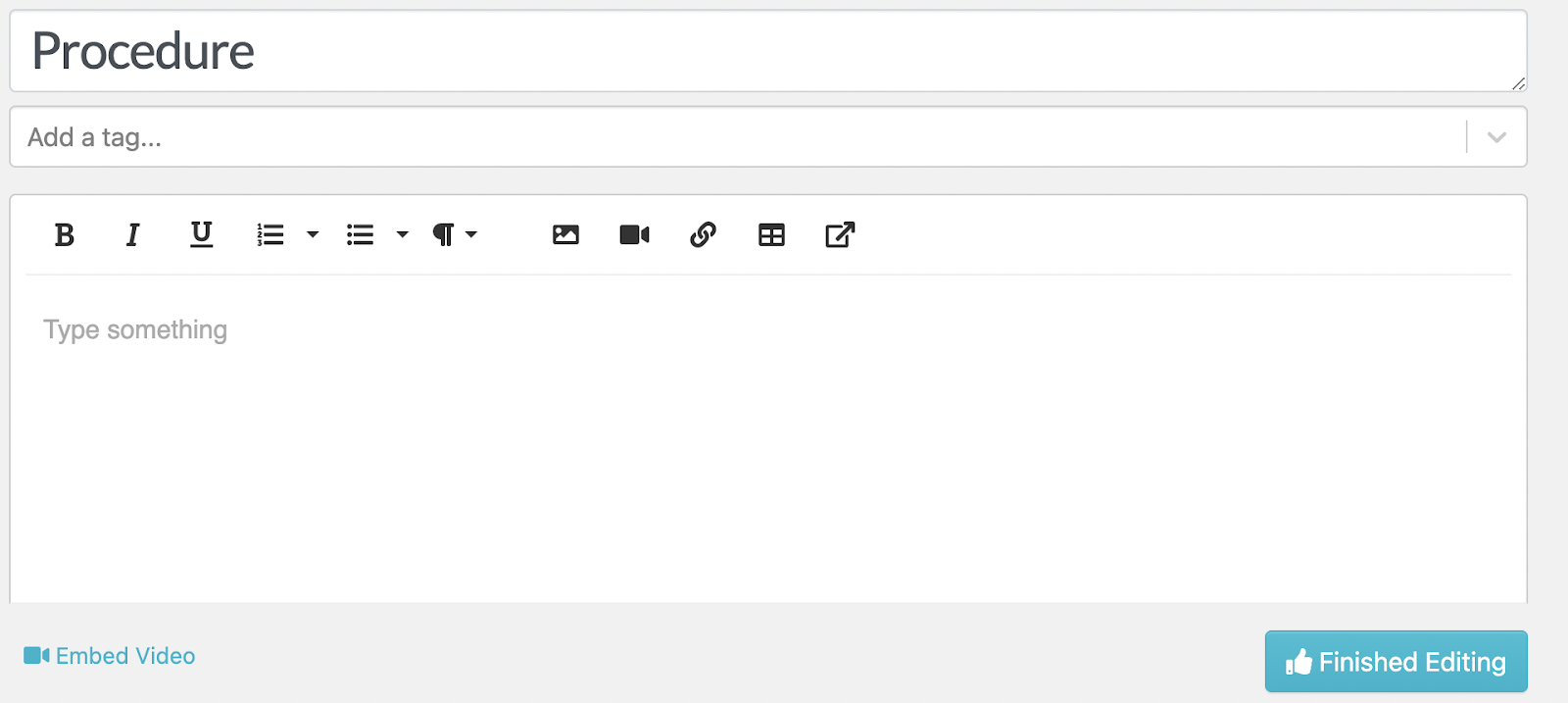
While this is a manual process, you can also use SweetAI to create the company procedures much faster. To use this feature, add a procedure title and click “Write with SweetAI.” The procedure will be generated in seconds.
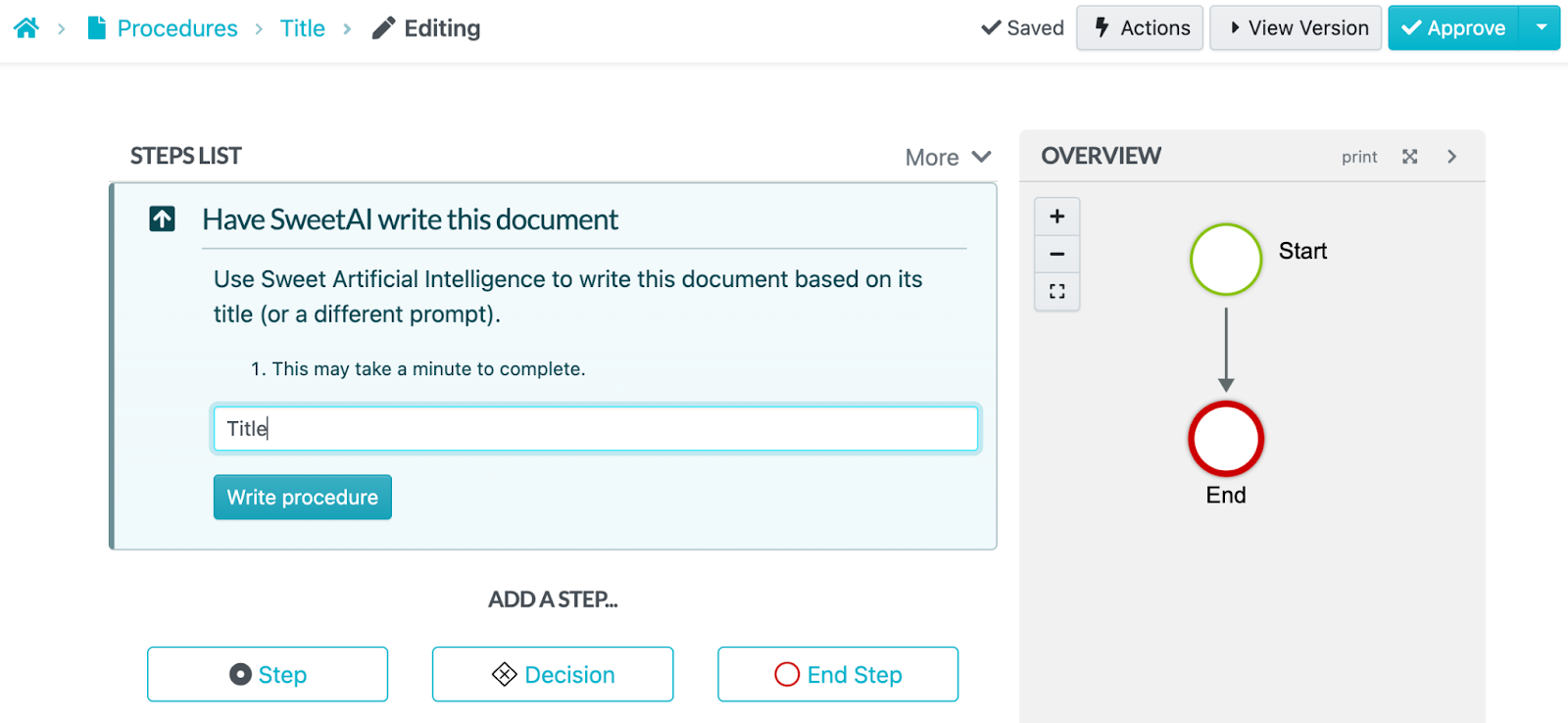
Creating a process on SweetProcess is also straightforward.
- Click “Processes” on the dashboard.
- Select “Create Process.”

- Include your new process title.
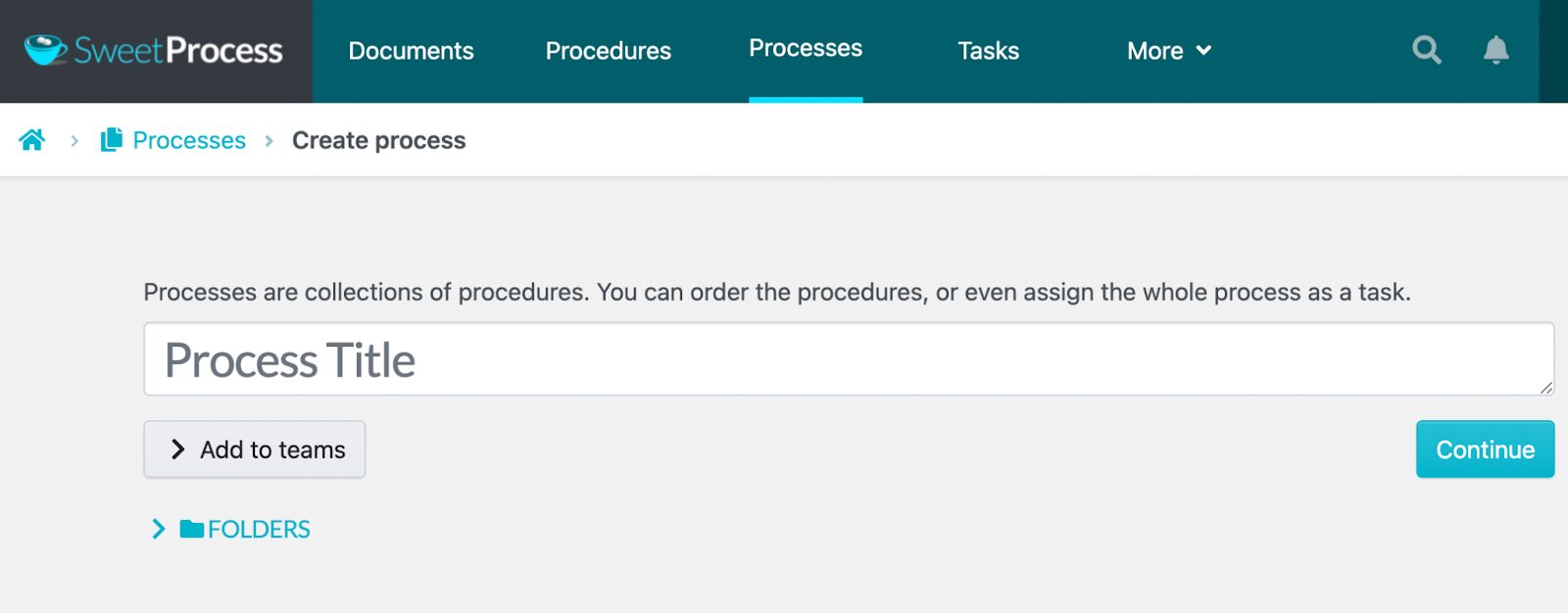
- Upload any tables, images, and videos that work with your process.
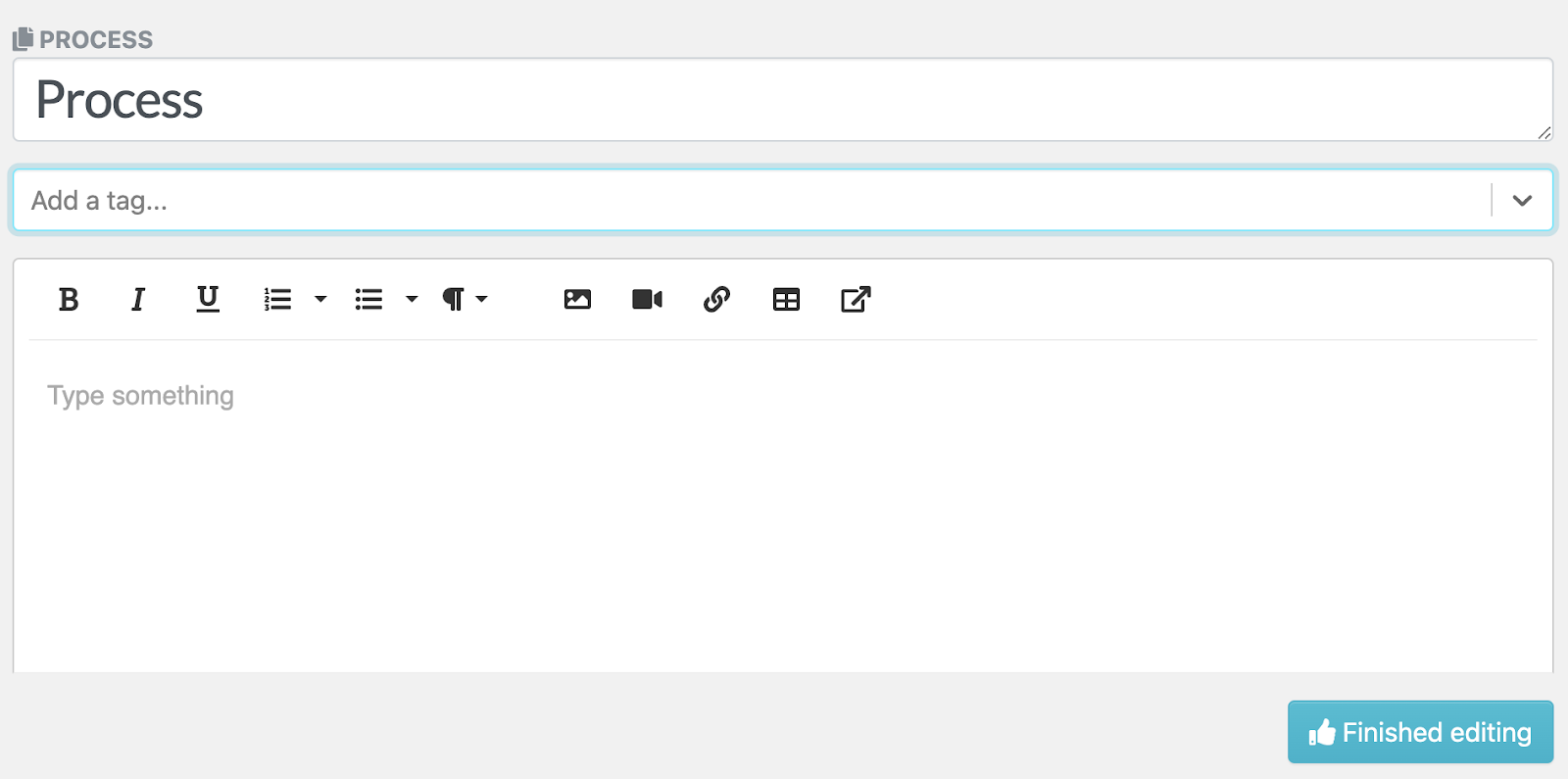
- Save your changes.
To create a policy, follow these steps:
- Select “More” on the SweetProcess dashboard.

- Tap “Policies.”

- Click “Create Policy.”

- Add a policy name.

- Assign the new policy to your teams and click “Continue.”

- Add details to your policy and save it.
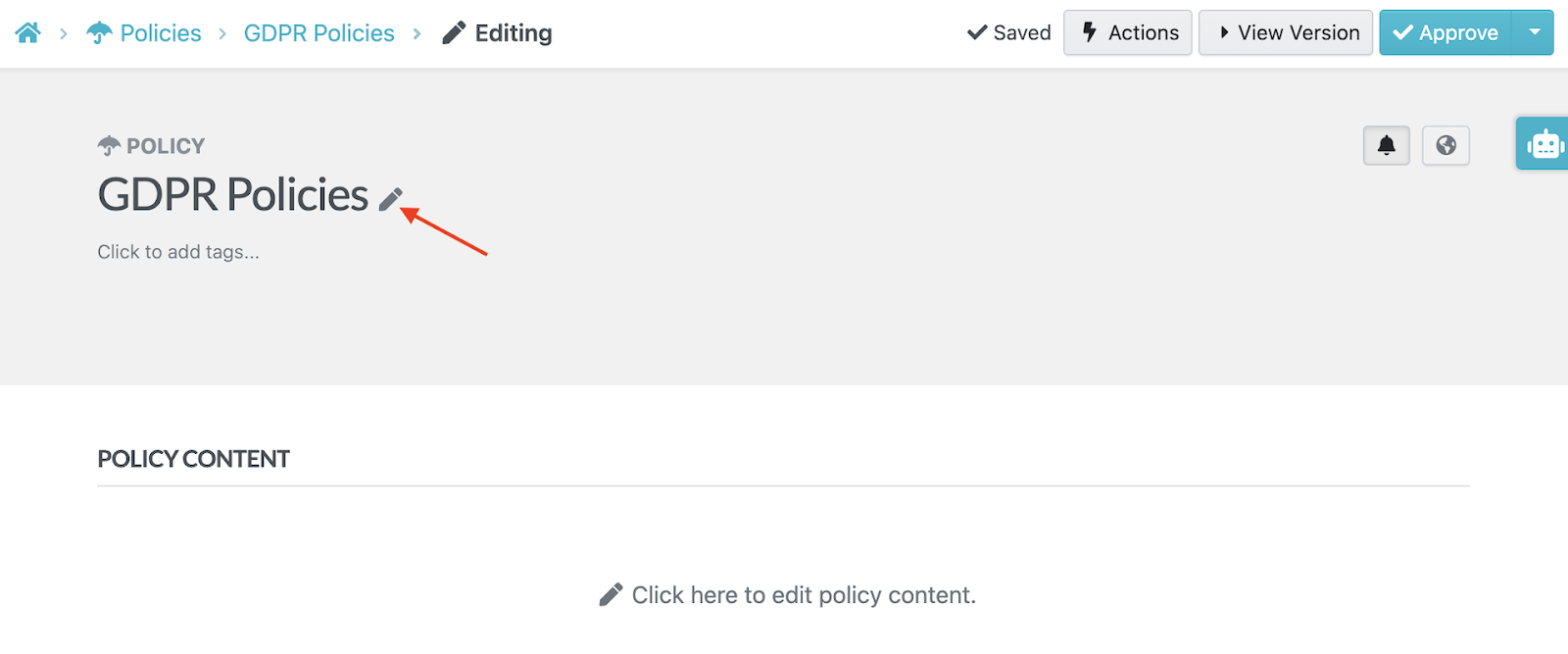
Once you save the policies, procedures, and processes, you can access them from the dashboard. Your team can use them when referring to company quality standards.
Build a Quiz to Assess Your Team’s Grasp of Company Policies, Processes, and Procedures
SweetProcess allows you to build quizzes and assessments to ensure your team understands the company’s quality procedures. This ensures that everyone is aligned and knowledgeable about the standards. Here’s how:
- Select “More” on the main menu and click “Quizzes.”

- Click “Create Quiz.”

- Add a quiz name and assign it to different teams.

- Include details about the quiz, select a pass mark, and add a duration.

If you scroll down to the section marked “Recommended Documents,” you can include the procedures, policies, and processes related to this quiz.

You also have the option to add open-ended or multiple-choice questions.

Click “Finished Editing” once done.
Turn Procedures and Processes Into Actionable Tasks
Once you have the procedures and processes on SweetProcess, you can turn them into actionable tasks. Here’s how:
- Open your procedure or process on the main dashboard.
- Select the specific process or procedure you need.
- Click on the three dots.
- Select “Assign as Task.”
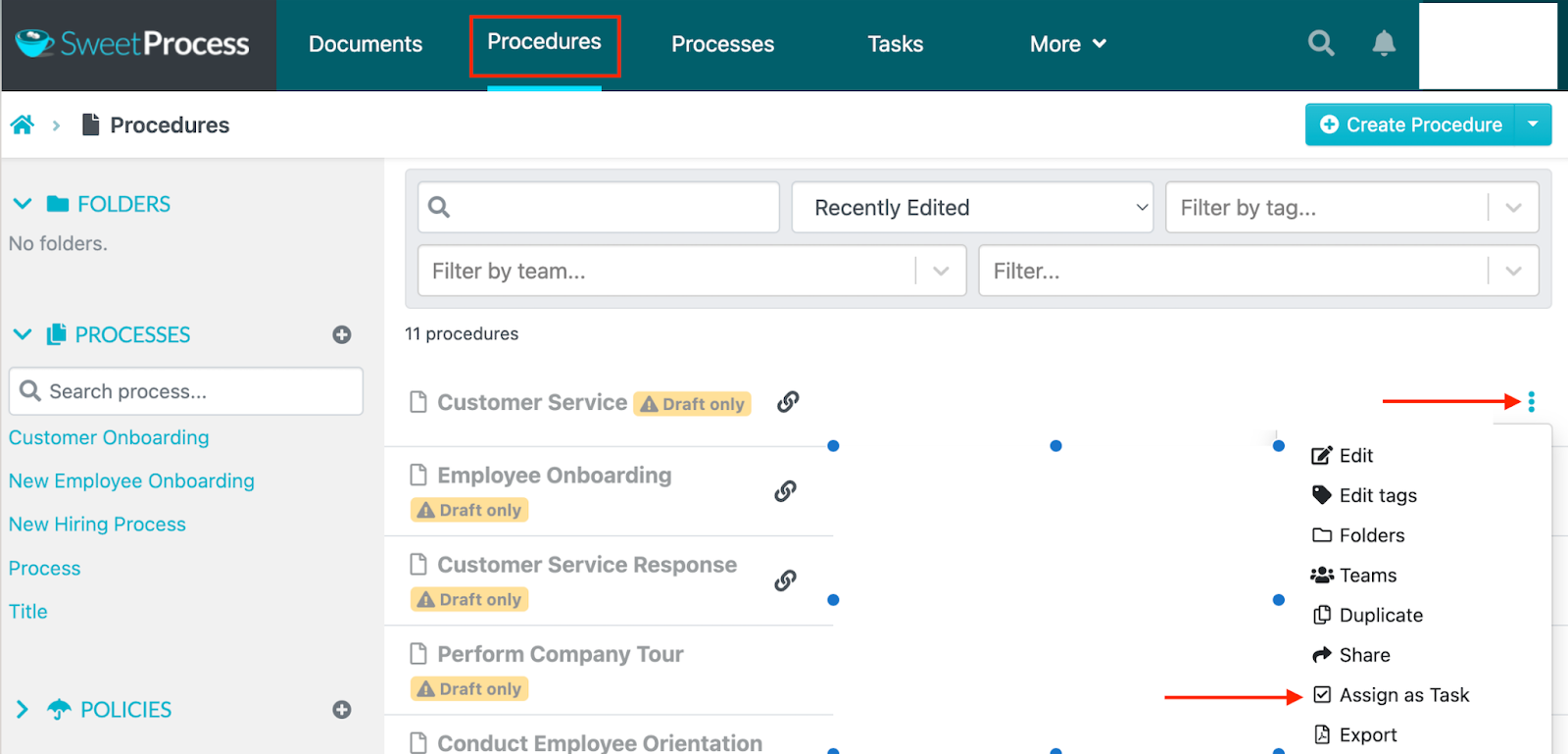
Alternatively, you can open the “Tasks” section.
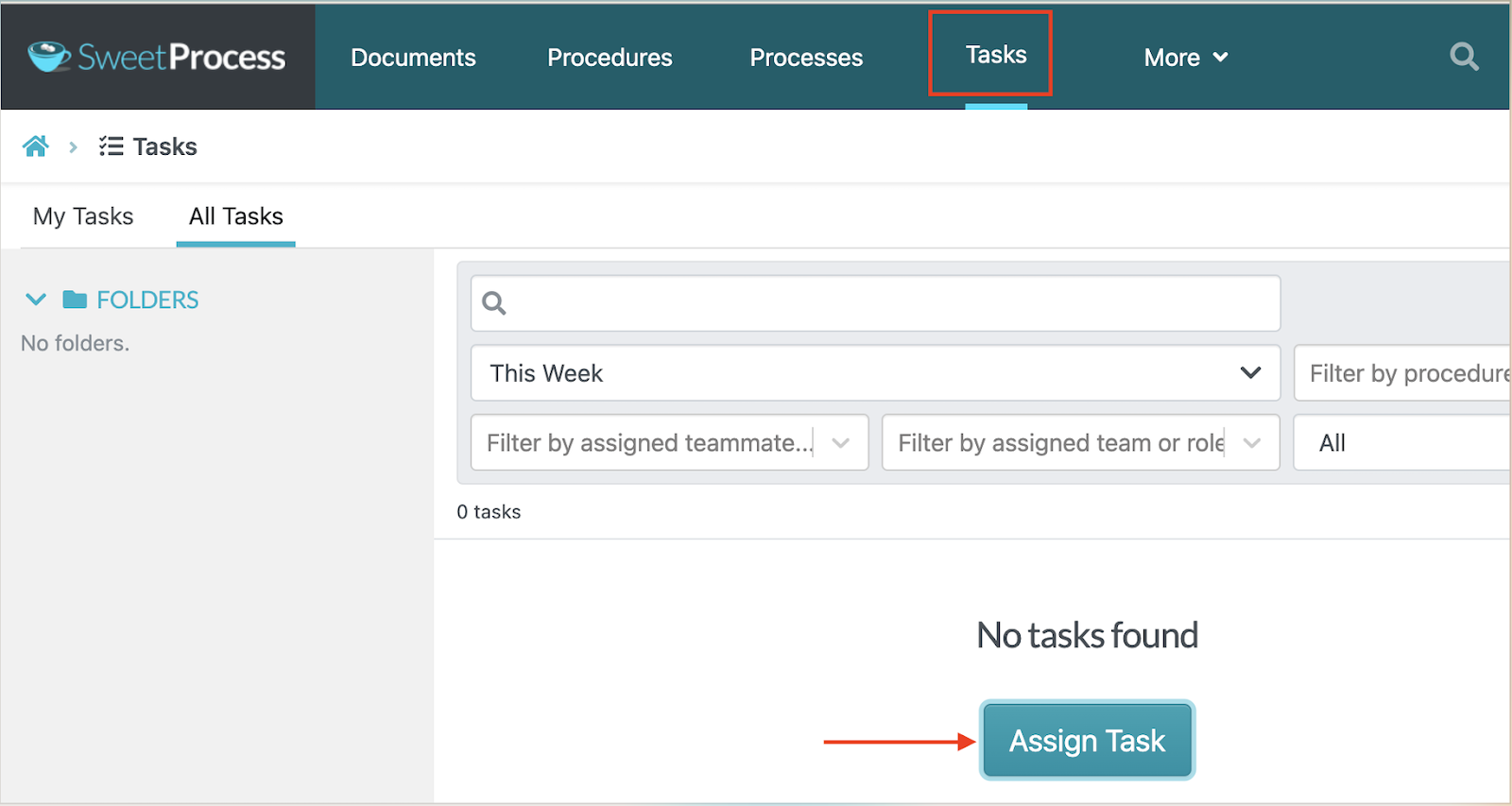
Click “Assign Task” and choose from the existing procedures or processes.
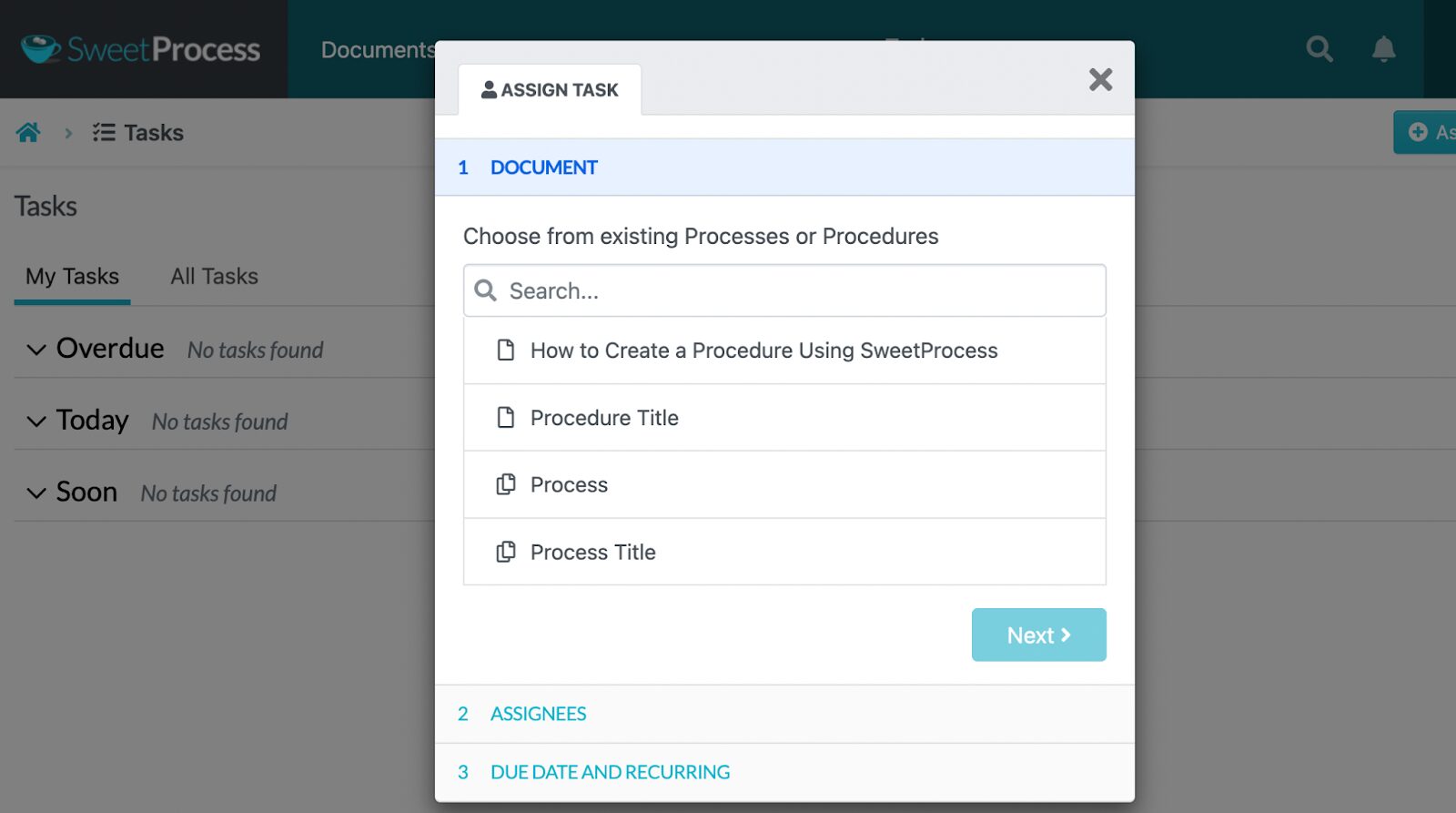
Turn Existing Procedures and Policies Into a Beautiful Knowledge Base
SweetProcess makes it easy to turn your existing procedures and policies into a well-organized knowledge base. This way, all your team members can quickly access the most up-to-date guidelines.
Here’s how:
- Open the “Procedures” or “Policies” tab.
- Select the specific procedure or policy to turn into a knowledge base.

- Tap the three dots on the right.
- Select “Knowledge Base.”
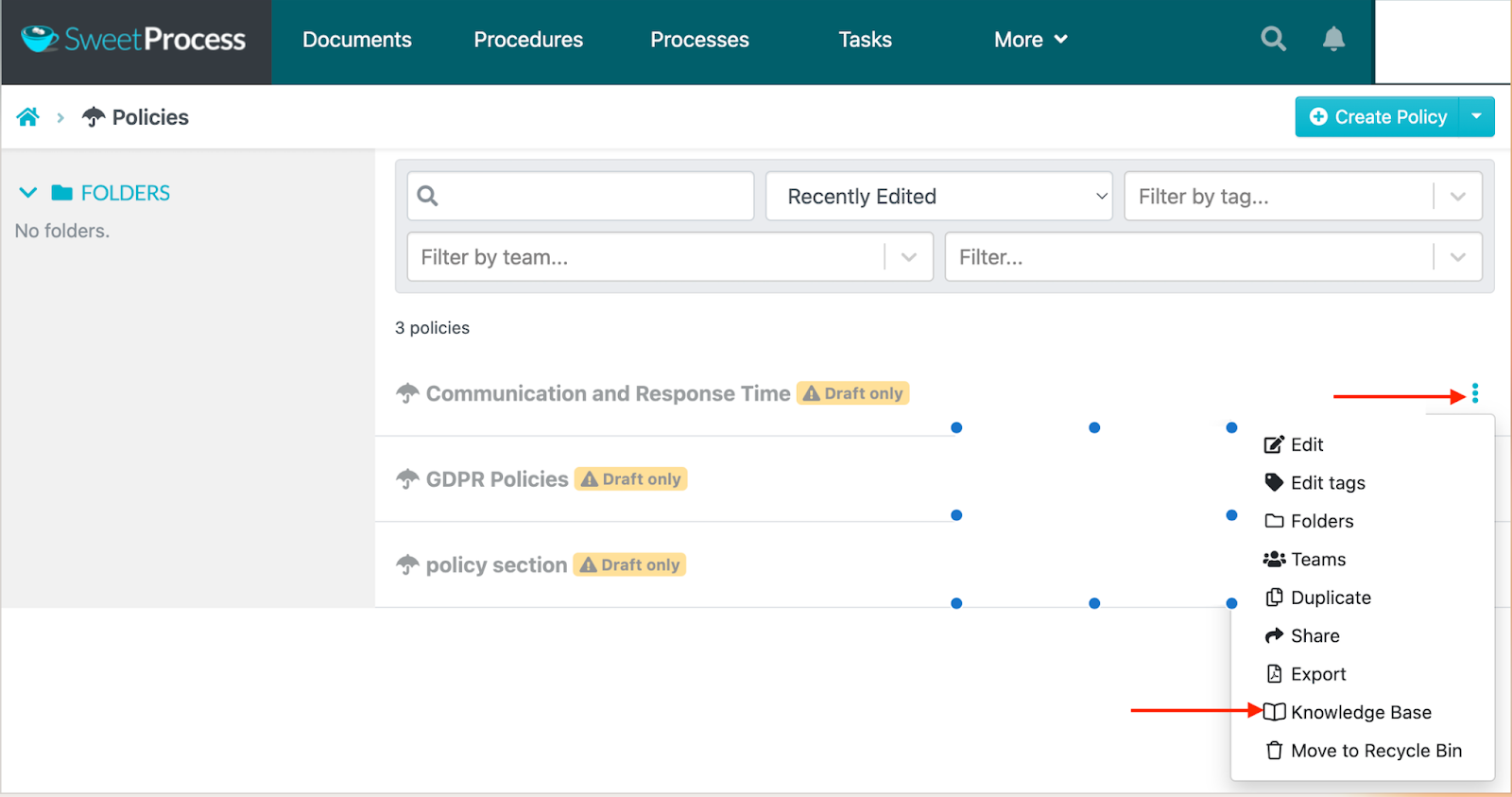
Add the procedure or policy to the knowledge base.
Manage Procedures, Processes, and Policies
With SweetProcess, you can manage and update your procedures, processes, and policies in real-time. This ensures that your quality management system is always current and effective.
Once you save your procedures, policies, and processes on SweetProcess, you can access them from the dashboard to delete, edit, or improve them.
- Select the specific process, procedure, or policy.
- Click the three dots on the right and pick an action from the pop-up.
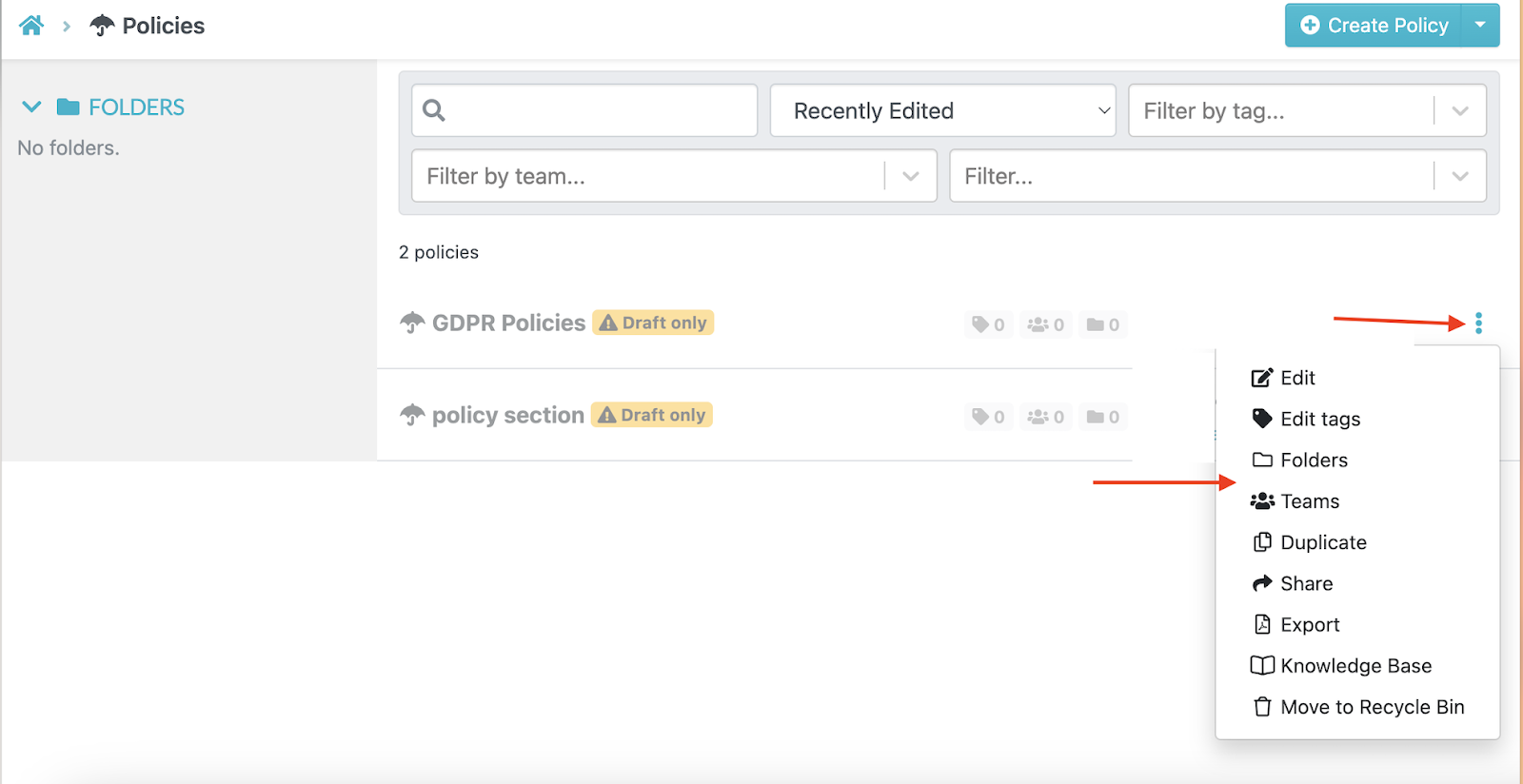
Set up Teams to Reflect Your Company Culture
Using this tool, you can create teams within your organization to reflect your company’s culture and values. This ensures that your quality management system aligns with the people and processes that define your business.
Follow these steps:
- On the top navigation bar, click “More” and then select “Team.”
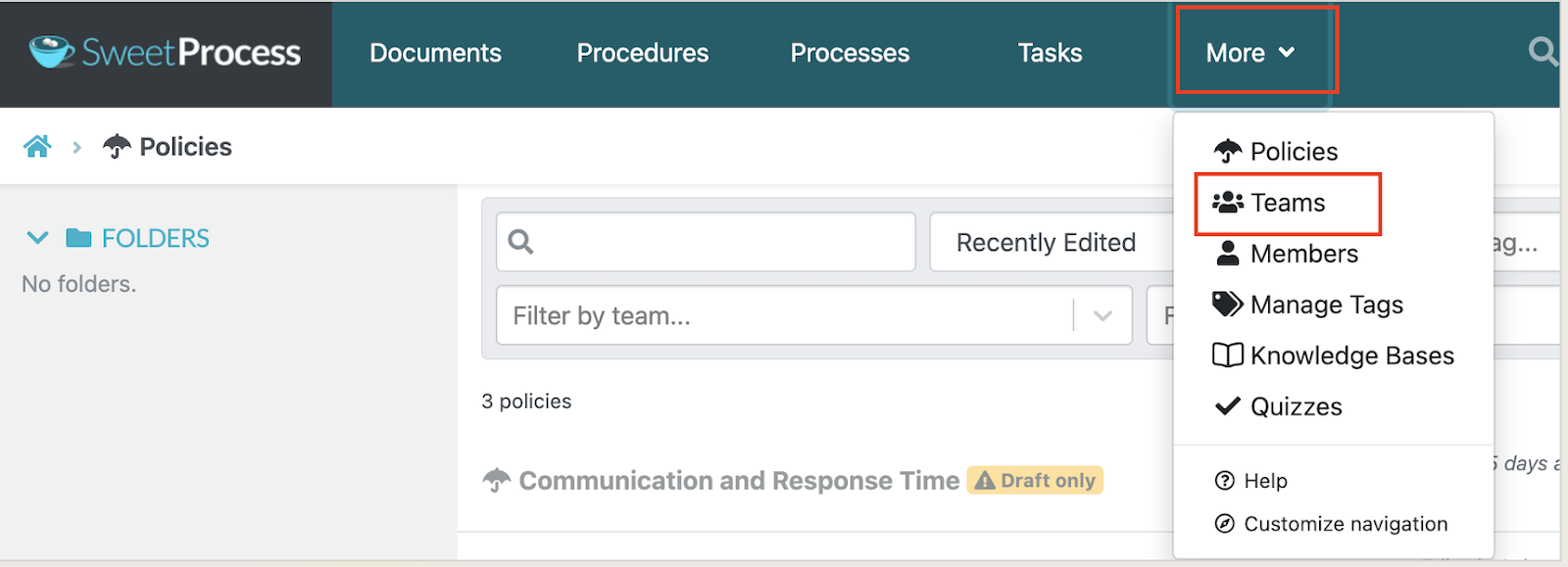
- On the next page, tap “Create Team.”

- A new page opens. Add your team details, including name and description, and then click “Create Team.”

These SweetProcess capabilities have been beneficial to several small business owners.
A good example is Resolute Legal, a Canadian law firm specializing in disability claims. In the early days, the founder and managing lawyer, David Brannen, ran the business solo, overwhelmed by the need for more structure. The absence of organized processes made it difficult to scale and manage the growing workload, leaving him unable to focus on business growth.
Brannen was advised to systematize his operations to grow successfully. After evaluating several tools, he chose SweetProcess because of its simplicity and ease of use, which helped him build a structured framework for the business. Since then, the company now uses SweetProcess for:
- Employee onboarding and training: SweetProcess allowed David to create clear, documented processes for new hires, reducing the need for direct training and ensuring a smooth onboarding experience.
- Central knowledge base: The company can now provide employees with up-to-date procedures and reduce constant queries about tasks.
- Quality control: SweetProcess standardized operations, ensuring consistency and quality across all tasks, improving overall efficiency.
- Streamlining workflow: By assigning tasks to specific teams and individuals, SweetProcess helped the team stay focused and organized without being overwhelmed.
SweetProcess helped Resolute Legal scale from a one-person operation to a structured business with a growing team, enabling David to focus on expanding the firm.
Florinela Serba, the head of operations at Onogo, is another happy user of SweetProcess. The successful e-commerce business based in Jersey, U, had grown to become one of Amazon’s top 1,000 global sellers, thanks to its dedication to continuous improvement and strong partnerships with top brands.
However, as the company expanded, it faced challenges in managing growth due to a lack of structured processes. With increasing demands from customers and partners, the business needed a solid operational structure to maintain efficiency. Serban started exploring various document management tools.
After trying out several options, she chose SweetProcess for its ease of use and ability to centralize all processes in one platform. Implementing SweetProcess came with these benefits:
- Easy process documentation: SweetProcess made documenting business processes simple and intuitive. The team could add videos, photos, and links to enhance the documentation, ensuring it was accessible and useful to all employees.
- Decentralized knowledge base: Onogo consolidated all its documents into one central location, making it easy for employees to access and update information.
- Speedy employee onboarding and training: New employees can easily reference the system to find the necessary information, reducing training time and improving efficiency.
- Quality control and assurance: SweetProcess helped standardize processes across departments, ensuring consistency in how tasks were performed. This improved collaboration and efficiency, particularly within the sales team, which boosted process alignment.
SweetProcess can also transform your operations in the same way, whether you need to document your processes, procedures, or policies. Start your free trial!
Proven Frameworks for Quality Management

We’ve established that implementing a quality management system will enhance your performance and customer experience. However, there are several frameworks to choose from. You should select the option that aligns with your industry. Let’s examine the established frameworks that can help you achieve business goals.
Total Quality Management (TQM)
Many organizations assume that quality management is the responsibility of quality assurance and quality control experts. Although you hired them to ensure the company meets the standards, the burden doesn’t lie solely on them.
Based on the Total Quality Management (TQM) philosophy, every team member should be involved in implementing quality. Your business needs to create a quality culture in all departments, from the production process to customer service. The TQM management strategy is comprehensive and ensures continuous process improvement.
Here are the key principles of TQM that you should follow:
- This approach relies on established processes to prevent errors.
- It focuses on customers to ensure the quality meets or exceeds their expectations.
- All employees must be involved in the quality improvement process.
- Data is collected to ensure that all decisions are based on factual information.
- There are no data silos across departments. Every team is integrated.
- You need clear communication plans to keep everyone aligned.
Six Sigma
While TQM focuses on improving systems and processes, Six Sigma focuses more on reducing defects and process variation. This data-driven methodology uses statistical tools to achieve the highest quality possible.
As a means of quality control, Six Sigma identifies and eliminates the root causes of problems, improving efficiency and quality. It’s based on the belief that every business process can be evaluated and optimized.
Businesses can use Six Sigma to:
- Define: This involves identifying the problem the company needs to solve.
- Measure: The employees measure the performance of the process to collect data.
- Analyze: Establishing the reason for the variation.
- Improve: The team starts working on the defects to improve the process.
- Control: You can add controls to ensure the process doesn’t fail again.
ISO 9001 Standards
ISO 9001 is an internationally recognized set of rules and regulations that provide a framework for quality management systems. It ensures that organizations meet customer and regulatory requirements while continually improving processes. Achieving ISO 9001 certification can help businesses build credibility and trust.
Additionally, it’s vital for trade across countries. Once you have the certification, you can assure your customers that your products and services are of high quality.
Lean Management Principles
The lean framework involves eliminating waste from the organization’s processes. Businesses use this management principle to create more value using fewer resources. Some of the non-value activities that Lean focuses on include:
- Overproduction
- Defects
- Unused potential
- A surplus of inventory
- Holds that delay production
- Extra processing
Tools for Enhancing Quality Management in an Organization

To successfully implement a QMS, businesses rely on a range of tools. These tools identify issues, track performance, and make data-driven decisions. Here are some essential tools for quality management:
Flowcharts
Flowcharts visually represent the steps in your process. They make it easier for you to identify bottlenecks, inefficiencies, and areas for improvement. You can even map out how tasks and activities flow from one stage to the next, providing clarity for team members.
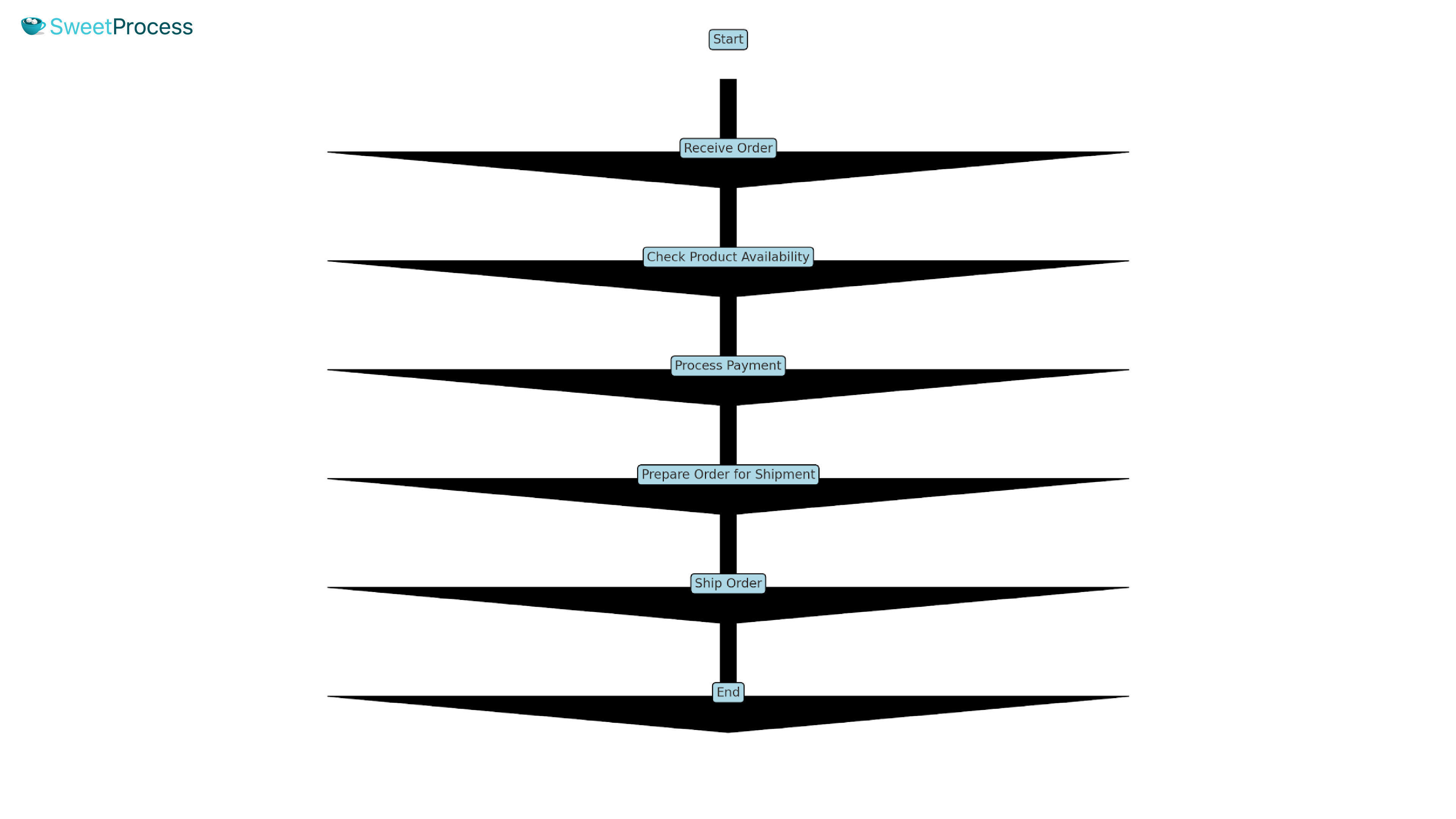
With a flowchart, you can simplify complex processes, making them easy to understand and analyze. In the long run, this reduces errors and allows for targeted improvements in your workflow.
Cause-and-Effect Diagram (Fishbone Diagram)
A cause-and-effect diagram, also known as a fishbone diagram, comes in handy when you need to identify the root cause of a problem. For instance, if the products are consistently defective, your fishbone diagram can trace whether the issue is materials, your employees, or the machinery.
Here’s an example of a cause-and-effect diagram with categories like “Methods,” “Machines,” “Materials,” and “People,” each leading to potential causes of defects in a product.
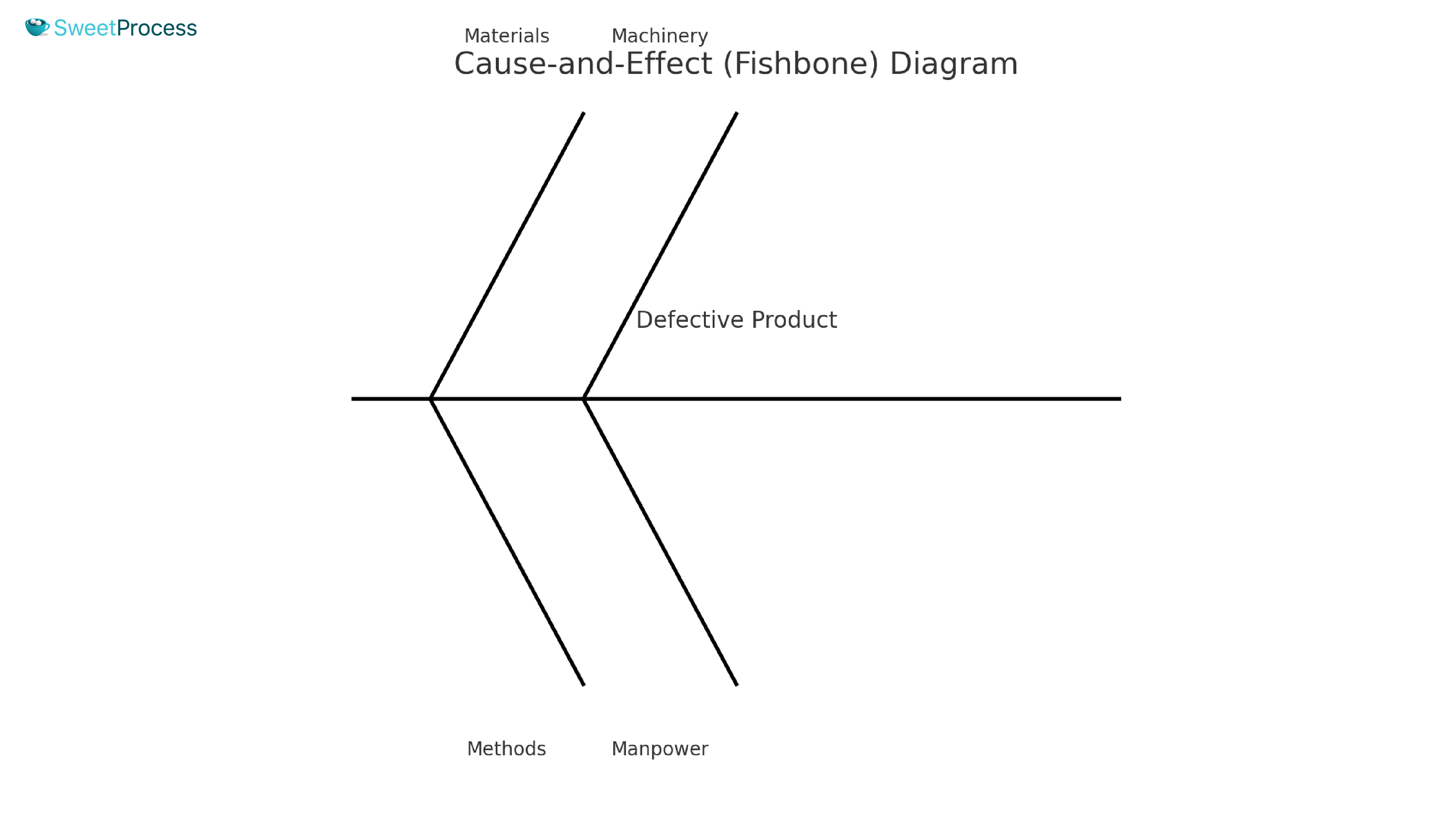
This tool improves problem-solving accuracy.
Check Sheets
You can use check sheets to collect data about defects or certain events. For instance, your quality control team might use this tool to monitor the number of defective products per shift. These insights can then be used to improve your processes.
This table helps you identify trends and patterns over time, allowing you to make data-driven decisions.
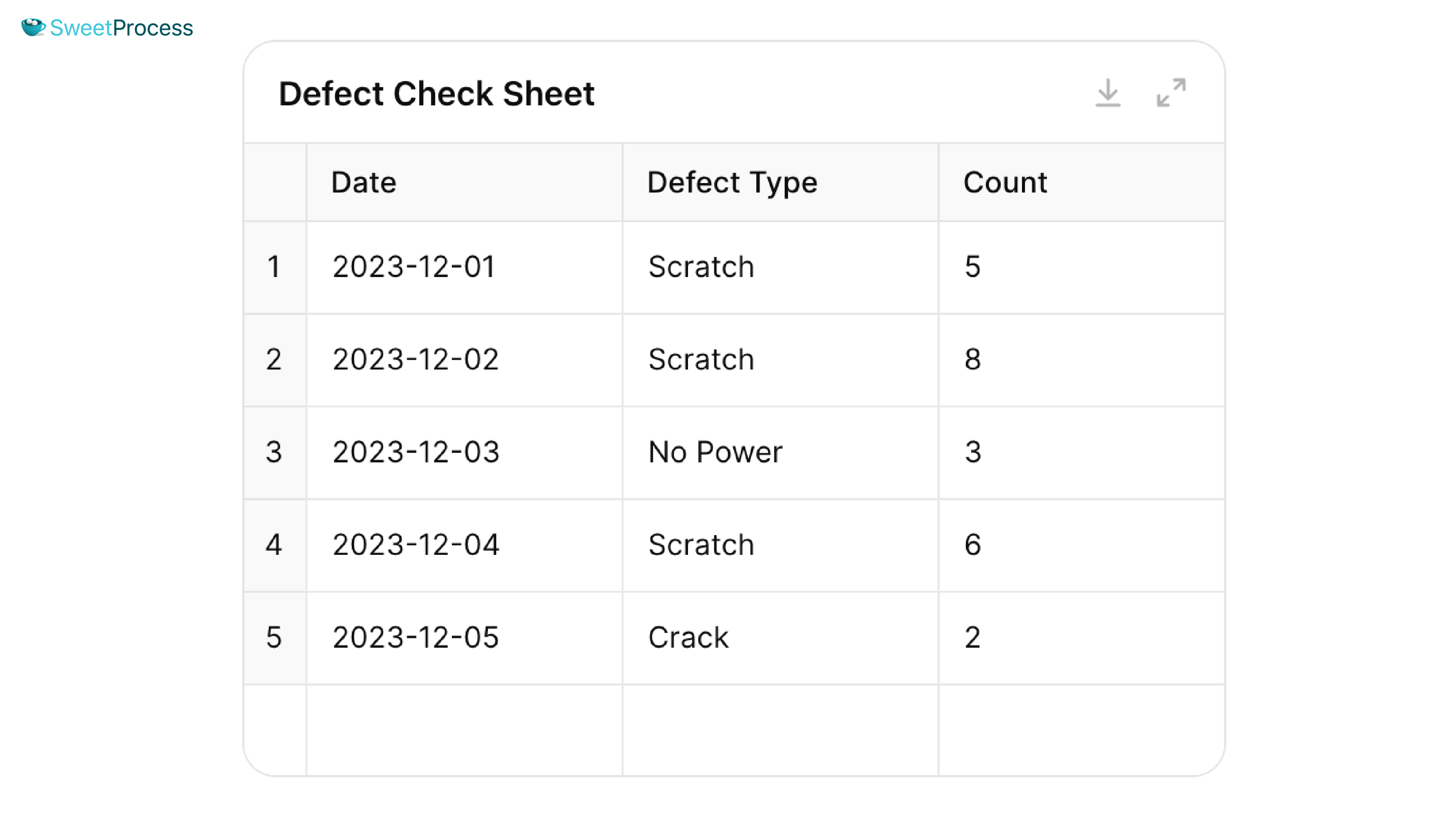
Your team can update information every time an incident happens.
Control Charts
Control charts track the process performance over time, showing how it varies from its expected output. The upper and lower control limits to determine whether the process is stable and in control. For example, a control chart can be used in a production line to monitor the size of a manufactured product component.
If the measurements fall outside the control limits, it indicates a need for corrective action.
Here’s an example of a graph showing product size measurements over several days, with control limits to indicate when the process is out of control.
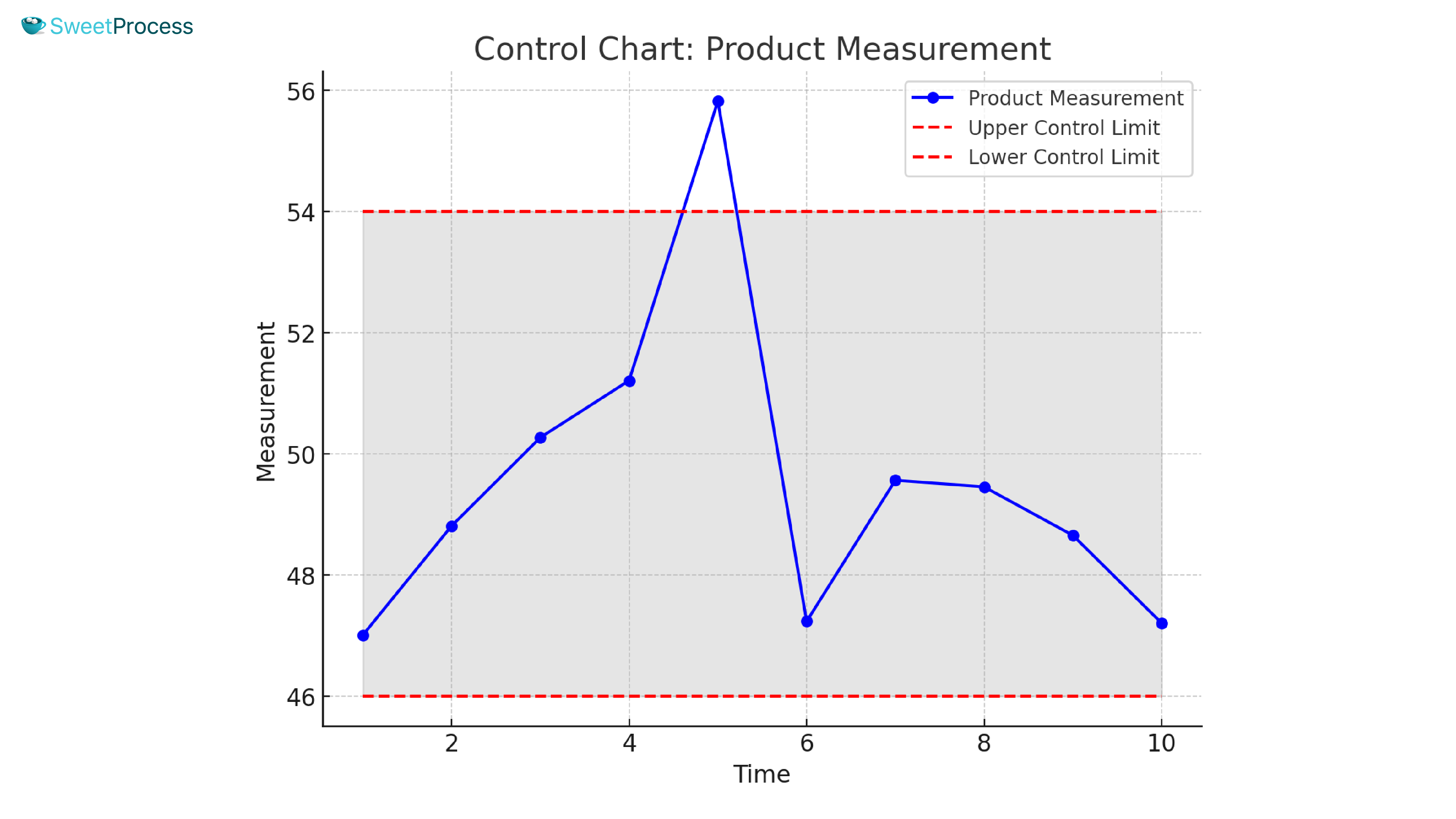
Pareto Analysis (80/20 Rule)
In some cases, your company’s problems are caused by specific issues. Pareto’s analysis uses the 80/20 rule, which states that 80% of problems come from 20% of causes. With this tool, you can determine which issues to address first based on the impact.
For instance, you might identify that 80% of customer complaints are related to only 20% of your products and services.
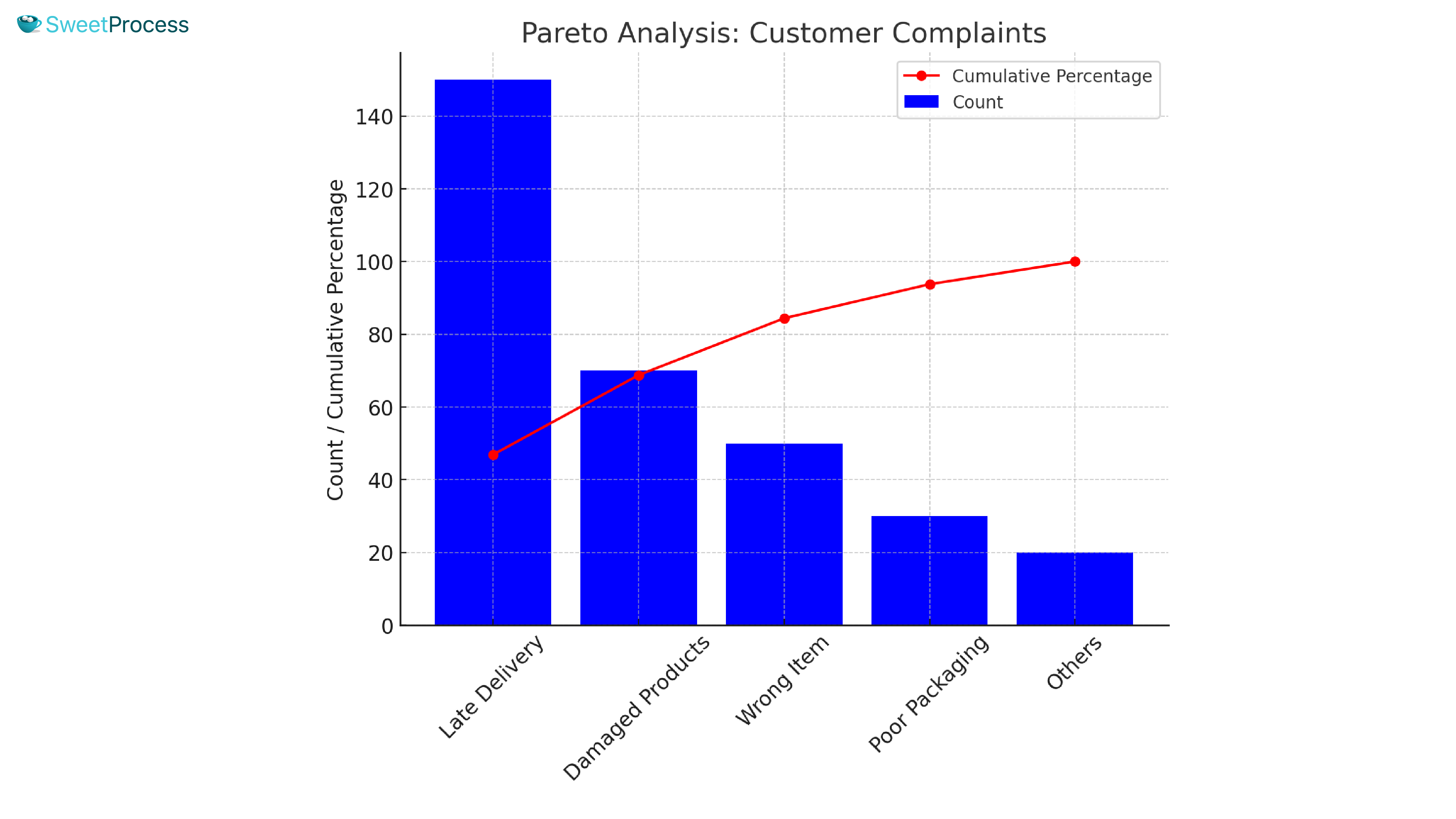
Based on this, you can make an action plan to improve the quality.
Histogram
This graphical representation shows the distribution of data to help you spot patterns. You can visualize the frequency of different values.
Your business can use a histogram to analyze customer satisfaction ratings, showing how many customers rate its service as excellent, good, or poor. This allows you to see trends in customer satisfaction and determine if there are quality issues.
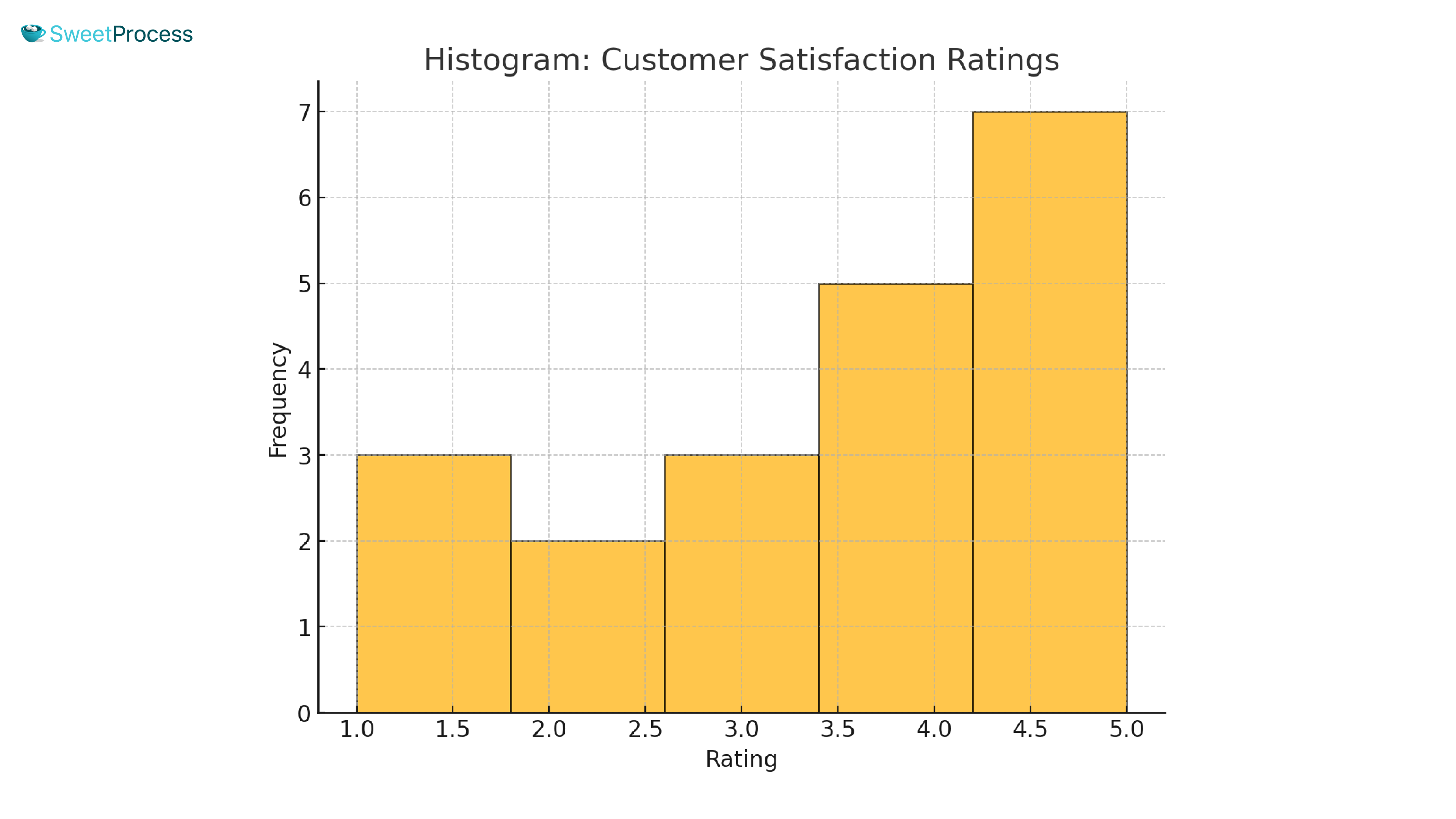
Scatter Diagram
Another tool for enhancing quality management is the scatter diagram, which shows the relationship between two variables. You can use it to examine the relationship between the number of customer service representatives and customer satisfaction ratings. With this data, you can optimize your staffing levels to boost the quality of services.
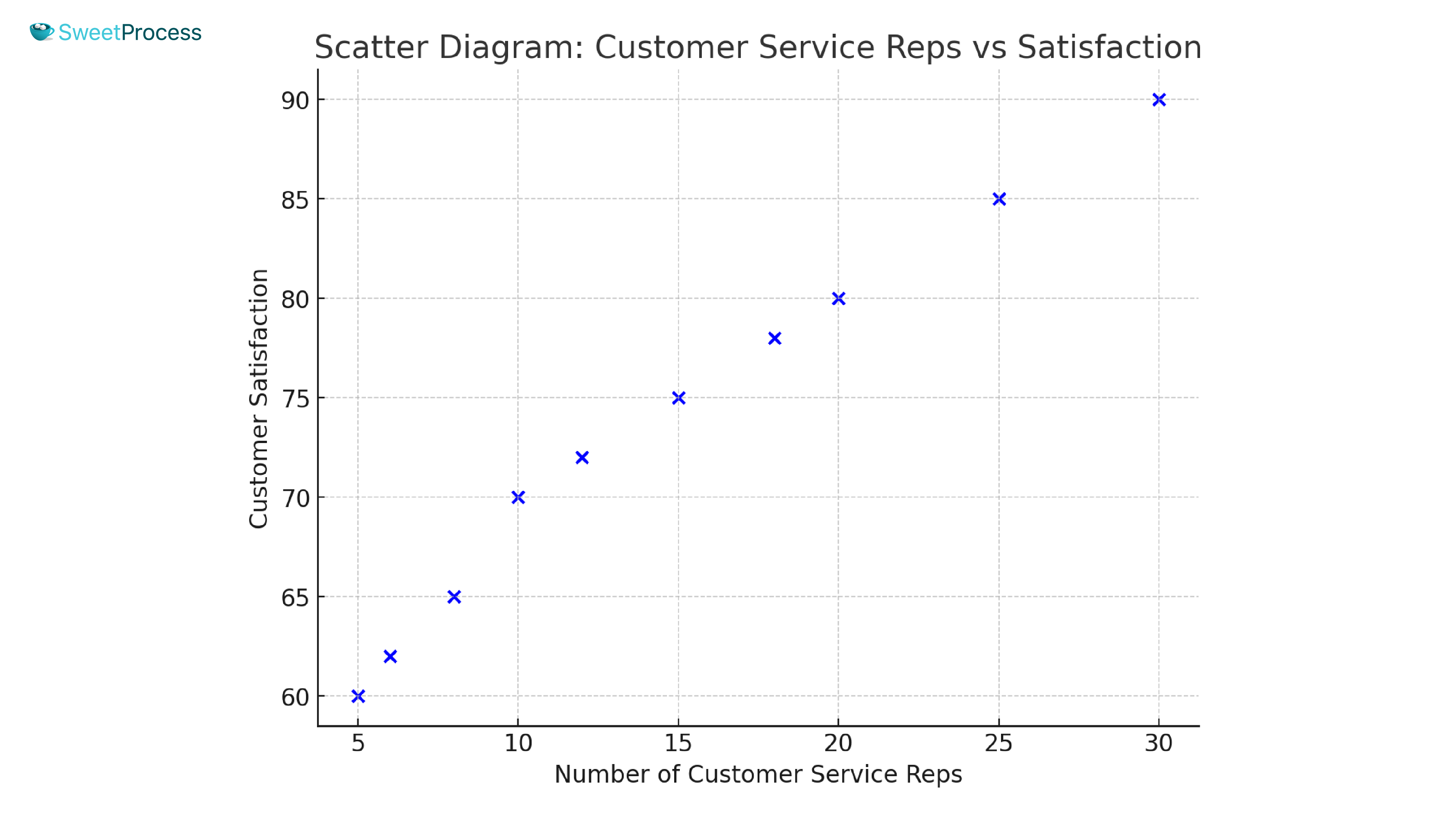
Stratification
You can use stratification to sort your data into categories and identify variations. For instance, you could separate product defects based on the shift, product type, or equipment used to reveal patterns.
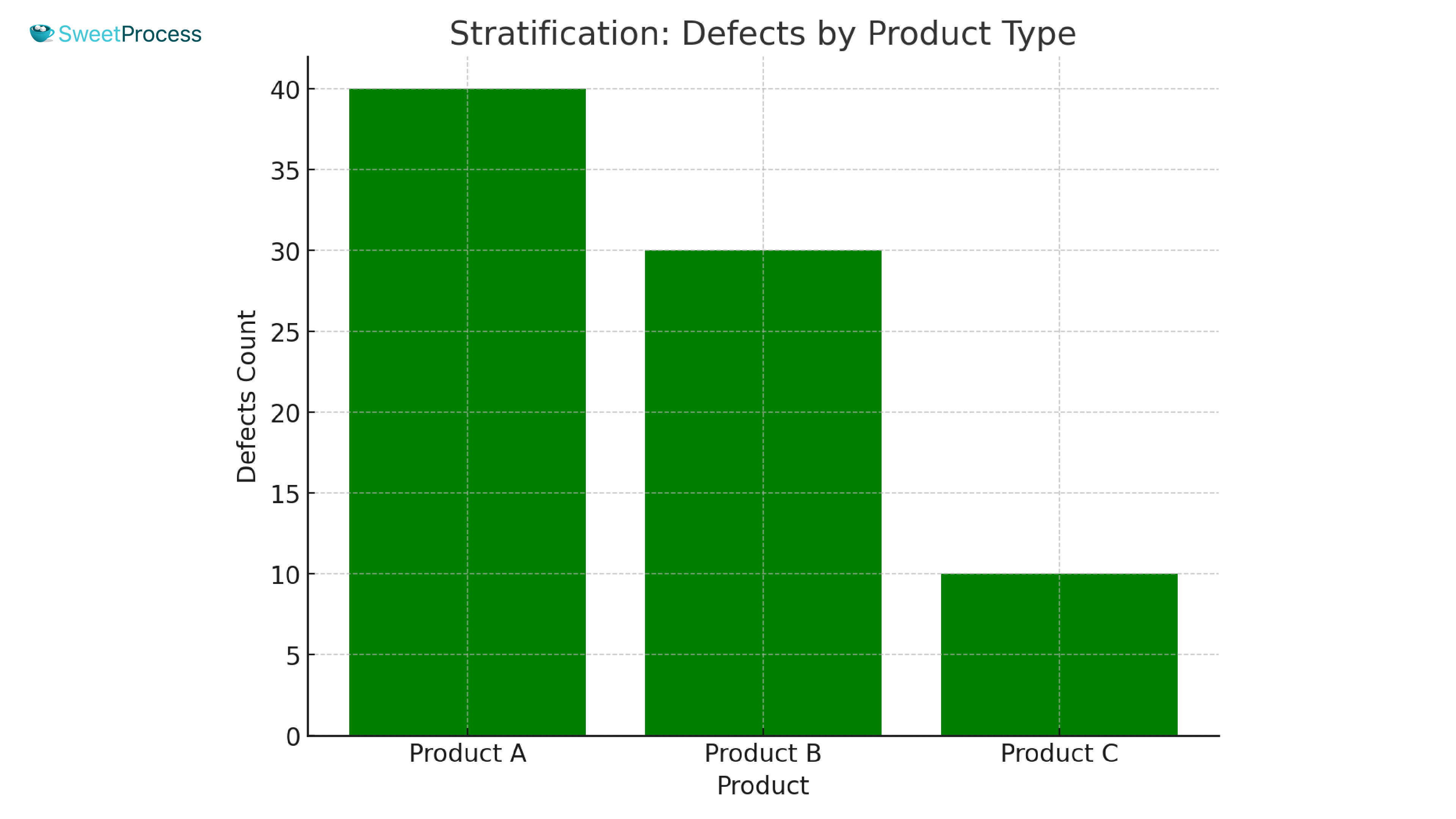
Analyzing data in smaller, manageable categories helps your business gain insights into specific problem areas, improving overall quality management.
Kaizen
This Japanese philosophy emphasizes continuous improvements, particularly in business operations. Employees at all levels should suggest and implement small changes in their departments to boost overall company efficiency and quality.
You can visualize this using a cycle diagram showing the process of Kaizen, with arrows linking continuous steps for improvement.
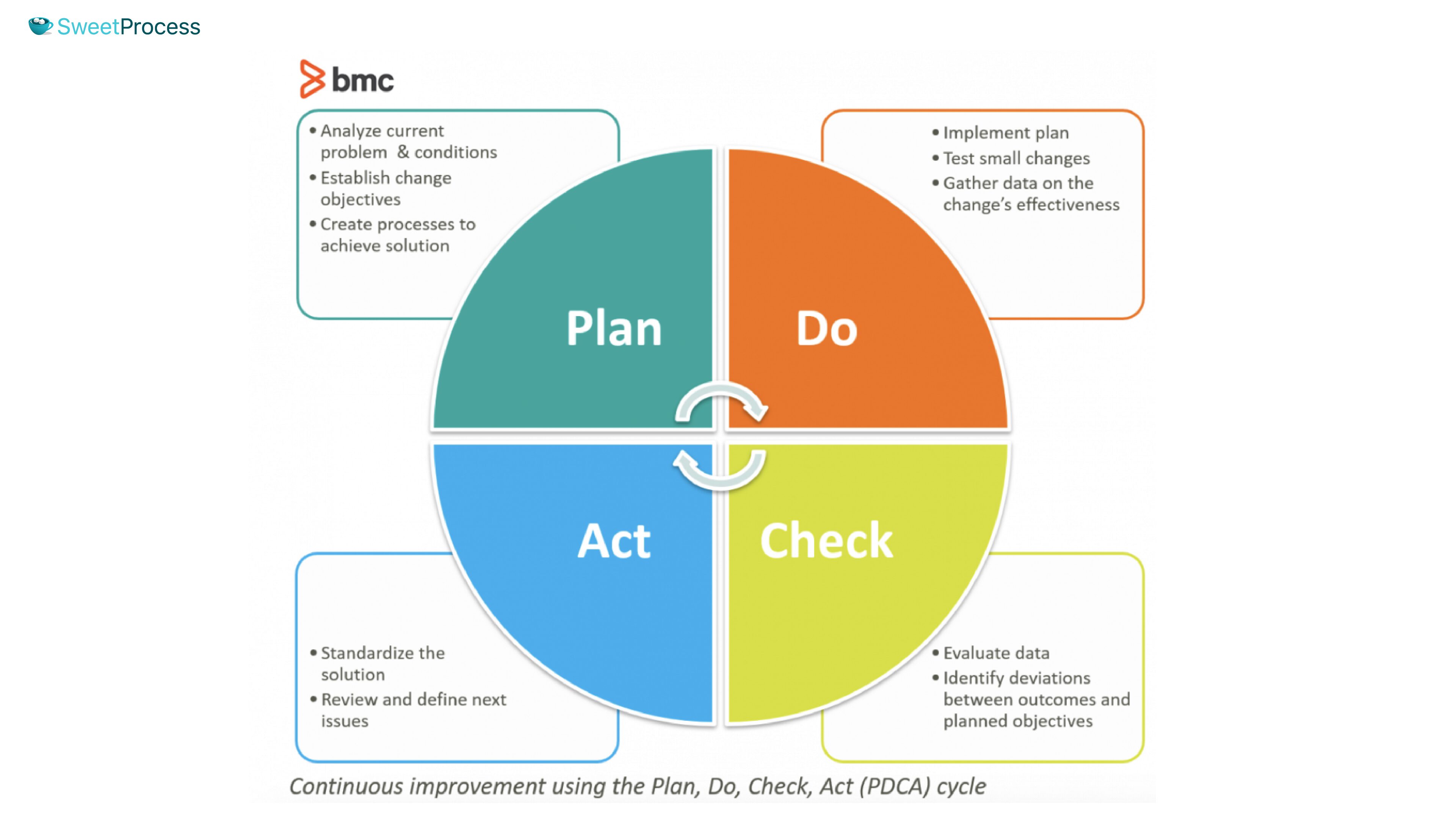
These quality management tools are essential for businesses looking to maintain consistency and improve product and service quality. Using these tools combined with SweetProcess, you can create a comprehensive approach to quality management that drives long-term success.
Principles of Quality Management
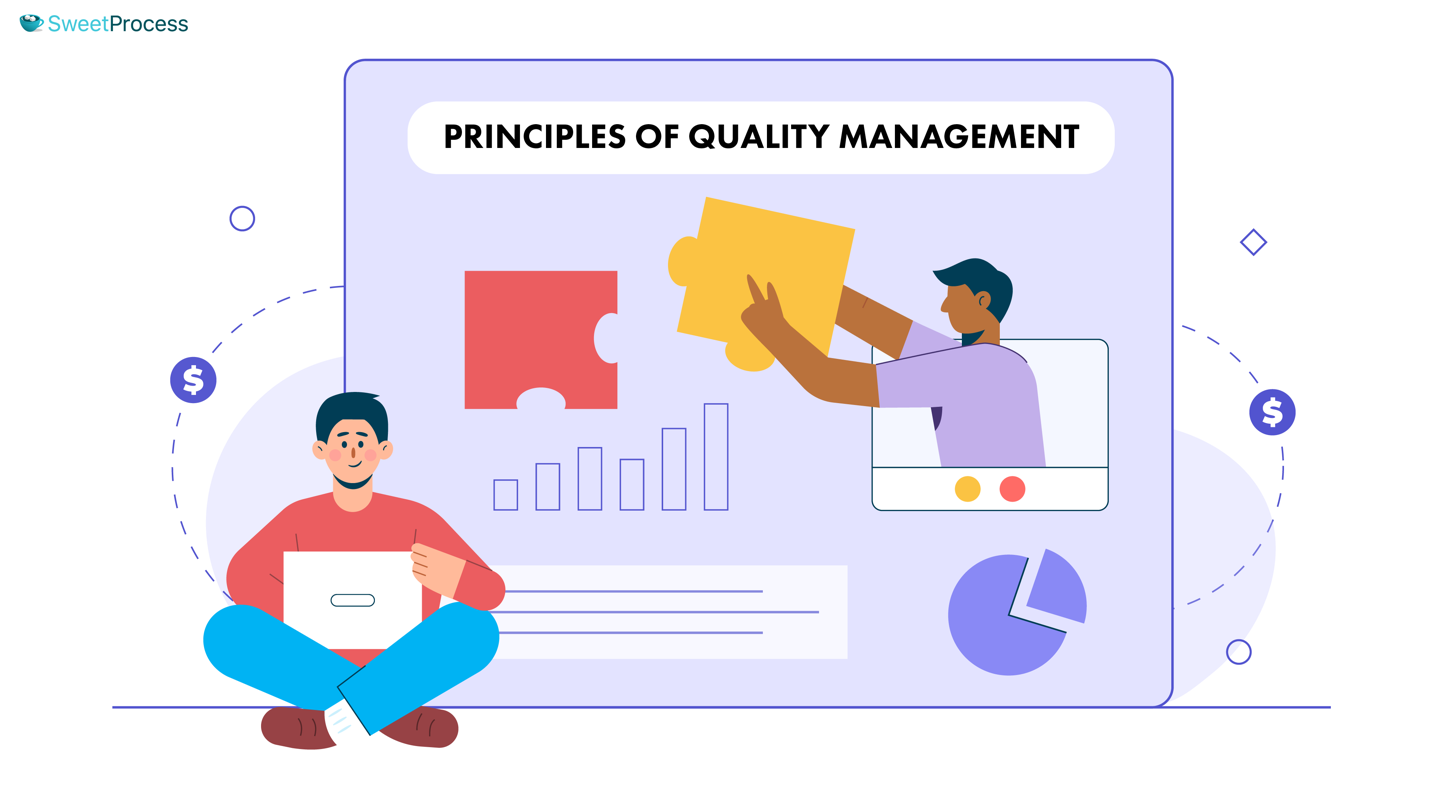
In your quest for excellence, several core principles should guide your organization in achieving consistent, high-quality outcomes. Let’s take a closer look at these principles:
Customer Focus
Your customers are a critical part of the business. To meet their expectations, you need to:
- Actively listening to feedback
- Conduct surveys to understand their needs
- Analyze market trends
Putting the customer at the center of everything the business does allows you to build solid relationships. You can learn from successful companies like Amazon that focus on fast delivery and personalized recommendations based on customer behavior.
Effectively fulfilling customer expectations builds loyalty. These customers will keep recommending your brand to others, driving growth. However, to achieve all of this, you need to maintain quality.
Leadership
Are you a good leader? Can your employees trust your vision to continuously improve your business processes?
Strong leaders inspire action, especially by empowering their teams to maintain the highest product quality standards. As a manager or business owner, you should create an environment where everyone works toward the same goal. Therefore, if you need to improve the product quality and reduce complaints, every employee puts more effort into this.
Engagement of People
Quality management should be a shared responsibility across all levels of the organization. Once you create the strategic vision, you can engage the employees to be actively involved, contribute ideas, and take ownership of their roles.
For instance, you can organize brainstorming sessions to get team members’ input on improving service delivery or your new product. When involved in decision-making and quality initiatives, employees become more invested in the company’s success. The higher the morale, the more innovative ideas you get.
Process Approach
Instead of approaching everything as isolated tasks, you should treat them as processes. All activities and resources should be an interconnected process toward a common goal. Once you understand how every process works, you can identify and reduce inefficiencies that affect your quality.
Frameworks like Lean and Six Sigma help you examine your processes and eliminate waste during production. Implementing this approach is good for the company’s overall quality goals.
Continuous Improvement
Your business will encounter challenges at one time. Instead of waiting for the issues to accumulate and make a one-time change, you can implement continuous improvement to enhance the processes, products, and services. These incremental changes will boost your efficiency over time.
Additionally, you can solve problems before they become too costly to fix.
Evidence-Based Decision Making
According to McKinsey, almost all employees will leverage data in their work in 2025. Innovative data techniques help resolve problems much faster. This is why you need evidence-based decision-making. Use factual information and data to guide decision-making, especially regarding the quality of your products and services.
For instance, you can use customer data to optimize your inventory management and personalize recommendations.
Relationship Management
Positive relationships yield better quality management processes. When you interact with your stakeholders, including customers, suppliers, and business partners, you get more information on whether your products and services make them happy.
Customers are more likely to remain loyal to a business that maintains high-quality standards. Therefore, you must do your part, address any complaints immediately, and constantly improve your services.
Enhance Your Quality Management Process With SweetProcess

When it comes to quality management, consistency and continuous improvement are key to staying ahead of your competitors. This process should be replicated across every business level for the best results. A well-structured QMS benefits your customer and business by boosting loyalty, improving efficiency, and achieving compliance.
But having the right tools makes things even better. SweetProcess helps you document, streamline, and improve your procedures, making it easier to track quality metrics. Our organized system for managing tasks ensures that everyone in your business is on the same page and working toward the same quality goals.
Whether you’re refining processes or onboarding new team members, SweetProcess is your partner in driving lasting quality improvements. Sign up for a free 14-day trial of SweetProcess and see how easy it can be to sustain high-quality standards across your business!
